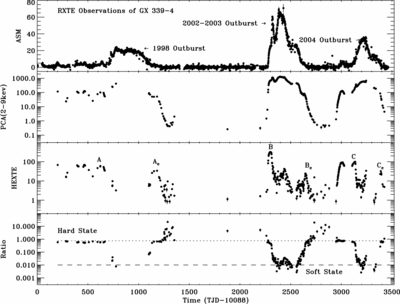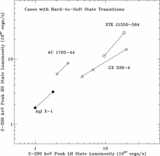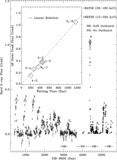Image Details

Caption: Fig. 1.
ASM (2–12 keV), PCA (2–9 keV), HEXTE (15–250 keV) light curves, and the HEXTE (15–250 keV)/PCA(2–9 keV) count rate ratio of GX 339‐4 in the past 9 years. The HEXTE peaks corresponding to the start of the hard‐to‐soft state transition and the end of the soft‐to‐hard state transition for the 1998 outburst are marked as ﹩A﹩ and ﹩A_{e}﹩; those of the 2002–2003 outburst are marked as ﹩B﹩ and ﹩B_{e}﹩, and those of the 2004 outburst as ﹩C﹩and ﹩C_{e}﹩. ﹩A﹩ is approximately at the same flux as the hard X‐ray peak before the hard‐to‐soft state transition (see Kong et al. 2002). Notice that the HEXTE peak rates corresponding to ﹩A﹩, ﹩B﹩, and ﹩C﹩ correlate with the ASM peak rates of these outbursts, and the peaks in the HEXTE band lead those in the ASM band.
Copyright and Terms & Conditions
© 2007. The American Astronomical Society. All rights reserved. Printed in U.S.A.





